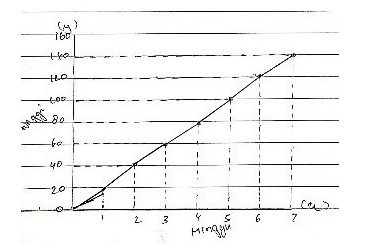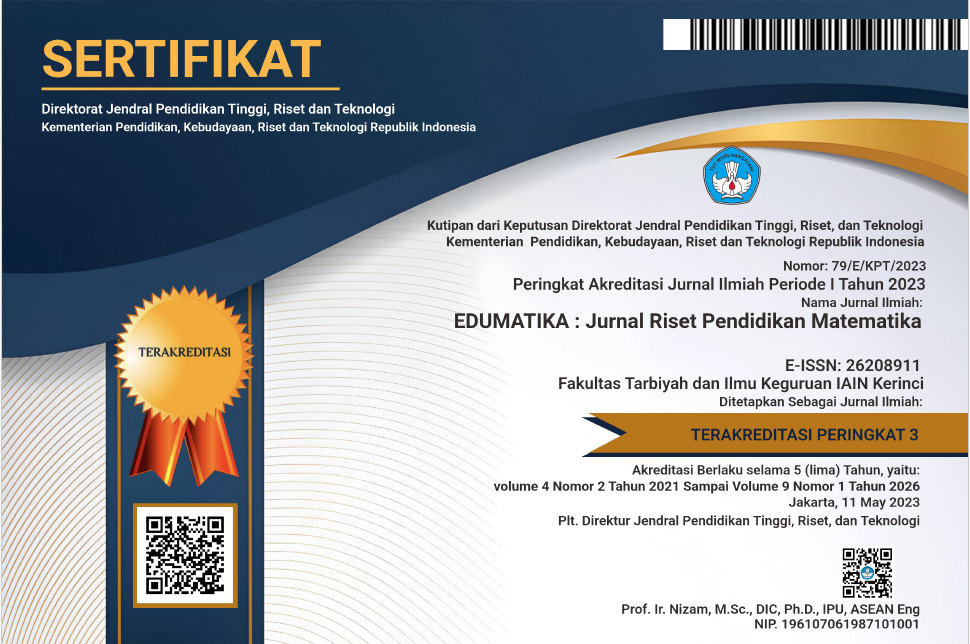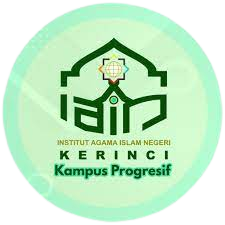The Students' Mathematical Literacy in Solving HOTS Problems: Does Learning Style Make a Difference?
Abstract
Differences in students' learning styles, whether visual, auditory, or kinesthetic, affect the way of students in absorbing, processing, and understanding the mathematical information provided. This statement indicates that differences in learning styles also affect students' mastery of mathematical literacy and students' skills in solving problems involving higher-order thinking skills. So, this study aims to describe students' mathematical literacy skills in solving higher-order thinking skills (HOTS)-oriented problems in terms of students' learning styles. The research used descriptive qualitative research that is involving 6 eighth-grade students at a junior high school in Blora, Central Java, Indonesia, as research subjects selected using simple random sampling techniques. The instruments used were a learning style questionnaire to identify students' learning styles, HOTS-oriented equation of a straight line problems to reveal students' mathematical literacy, and interviews to confirm the answers given by students in the test. Data were analyzed using an interactive model, namely data reduction, data presentation, and data verification, accompanied by triangulation techniques to ensure the validity of the data. The results showed that students with a visual learning style were more dominant in mastering communication skills and the ability to use language and symbolic, formal, and technical operations. In contrast, students with auditory learning styles are only dominant in mastering communication skills. While students with kinesthetic learning styles are more dominant in mastering language use skills and symbolic, formal, and technical operations.
Downloads
References
Acharya, N. H. (2021). Mathematics teachers’ perceptions on higher order thinking skills. International Journal of Multidisciplinary Perspectives in Higher Education, 6(2), 105–125. https://ojed.org/jimphe/article/view/3772
Afsari, S., Safitri, I., Harahap, S. K., & Munthe, L. S. (2021). Systematic Literature Review: Efektivitas Pendekatan Pendidikan Matematika Realistik pada Pembelajaran Matematika. Indonesian Journal of Intellectual Publication, 1(3), 189–197. https://doi.org/10.51577/ijipublication.v1i3.117
Ahyansyah, A. (2019, December). Kemampuan literasi matematika siswa sekolah dasar ditinjau dari gaya belajar. In Prosiding Seminar Nasional Lembaga Penelitian Dan Pendidikan (LPP) Mandala (pp. 78–87). https://ejournal.mandalanursa.org/index.php/ProsEko/article/view/983
Amaliya, I., & Fathurohman, I. (2022). Analisis Kemampuan Literasi Matematika Ditinjau dari Gaya Belajar Siswa Sekolah Dasar. Jurnal Riset Pendidikan Dasar, 5(1), 45–56. https://doi.org/10.26618/jrpd.v5i1.7294
Annur, A., Hermanto, & Anas. (2018). Analisis Kemampuan Literasi Matematika Siswa SMP Kelas IX Ditinjau dari Gaya Belajar. Jurnal Pendidikan Matematika Sigma Didaktika, 6(1), 22–32. https://ejournal.upi.edu/index.php/SIGMADIDAKTIKA/article/view/51400
Apino, E., & Retnawati, H. (2017). Developing instructional design to improve mathematical higher order thinking skills of students. Journal of Physics: Conference Series, 812(1). https://doi.org/10.1088/1742-6596/755/1/011001
Azizah, U. N., Puspitorini, A., & Zakiyah, S. (2019). Profil Kemampuan Literasi Matematika Siswa Ditinjau dari Gaya Belajar. Jurnal Inovasi Pembelajaran Matematika, 1(1), 11–18. https://www.e-jurnal.stkippgrisumenep.ac.id/index.php/JIPM/article/view/32
DePorter, B., & Hernacki, M. (2007). Quantum learning: Unleashing the genius in you (A. Abdurrahman, Trans.). Kaifa (Original work published 1992)
Fajaryani, M. (2017). Prestasi belajar matematika ditinjau dari gaya belajar siswa kelas VII SMP Negeri di Kecamatan Ambal. EKUIVALEN - Pendidikan Matematika, 30(1), 70–74.
Fitriyaningsih, I., & Ni’mah, K. (2023). Analisis Kemampuan Literasi Matematika Ditinjau Dari Tipe Kepribadian Rationals Dan Artisans. Jurnal Ilmiah Pendidikan Matematika, 8(2), 258–266. https://doi.org/10.26877/jipmat.v8i2.15000
Genc, M., & Erbas, A. K. (2019). Secondary Mathematics Teachers ’ Conceptions of Mathematical Literacy. International Journal of Education in Mathematics, Science, and Technology (IJEMST), 7(3), 222–237. https://ijemst.net/index.php/ijemst/article/view/611
Hartini, S. T., & Setyaningsih, R. (2023). Analisis Kesalahan Siswa Dalam Menyelesaikan Soal Geometri Berbasis Higher Order Skill (HOTS) Berdasarkan Teori Newman Ditinjau dari Gaya Belajar Siswa. Jurnal Cendekia: Jurnal Pendidikan Matematika, 7(1), 932–944. https://doi.org/10.35706/sjme.v7i1.6586
Hillman, A. M. (2014). A literature review on disciplinary literacy: How do secondary teachers apprentice students into mathematical literacy? Journal of Adolescent and Adult Literacy, 57(5), 397–406. https://doi.org/10.1002/jaal.256
Kurtuluş, A., & Ada, T. (2017). Evaluation of Mathematics Teacher Candidates’ the Ellipse Knowledge According to the Revised Bloom’s Taxonomy. Universal Journal of Educational Research, 5(10), 1782–1794. https://doi.org/10.13189/ujer.2017.051017
Kusuma, D., Sukestiyarno, Y. L., Wardono, & Cahyono, A. N. (2022). The characteristics of mathematical literacy based on Students’ executive function. European Journal of Educational Research, 11(1), 193–206. https://doi.org/10.12973/eu-jer.11.1.193
Mahmudin, N. A., Ariyanto, L., & Nugroho, A. A. (2023). Analisis Literasi Matematis Ditinjau dari Gaya Belajar Siswa. Imajiner: Jurnal Matematika Dan Pendidikan Matematika, 5(3), 188–193. https://doi.org/10.26877/imajiner.v5i3.14452
OECD. (2019). PISA 2018 Assessment and Analytical Framework. PISA, OECD Publishing, Paris. https://doi.org/10.1787/b25efab8-en.
Putri, F. E., Amelia, F., & Gusmania, Y. (2019). Hubungan Antara Gaya Belajar dan Keaktifan Belajar Matematika Terhadap Hasil Belajar Siswa. Edumatika: Jurnal Riset Pendidikan Matematika, 2(2), 83–88. https://doi.org/10.32939/ejrpm.v2i2.406
Stacey, K. (2015). The International Assessment of Mathematical Literacy: PISA 2012 Framework and Items. 12th International Congress on Mathematical Education, 771–790. https://doi.org/10.1007/978-3-319-17187-6_43

Copyright (c) 2024 Salfadhilla Najma Khan, Rini Setyaningsih

This work is licensed under a Creative Commons Attribution 4.0 International License.














